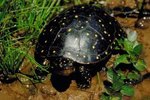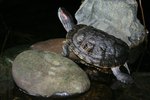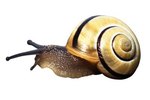
The pink-bellied side-necked turtle (Emydura subglobosa), also called the red-bellied short-necked turtle, is a freshwater species relatively new to the North American pet trade. As the name suggests, this species has a pink to red belly, with shells in varying shades of beige, gray and brown. It is referred to as a “side-necked” turtle because it pulls its head sideways rather than straight back to retreat into its shell. Native to Australia and New Guinea, this freshwater turtle species can live 30 to 50 years with proper care.
Habitat
A single pink-bellied side-necked turtle hatchling, at about 4 inches long, needs a 20-gallon aquarium at a minimum. The species does well in groups, provided the size of the enclosure is increased by at least 10 percent for each additional turtle. As the hatchling grows, its area should be increased by 10 gallons for each inch it grows. Adults reach lengths of 8 to 9 inches. If the water isn’t constantly flowing, the turtle benefits from a filtration system to keep its water clean between changing. River sand at the floor of the enclosure mimics the turtle’s natural habitat. Rocks, greenery, cork bark, and partially-submerged logs or other ramps enable the turtle to leave the water when it wants to bask.
Temperature and Lighting
Pink-bellied side-necked turtles are aquatic turtles, and spend most of their time in the water. They do require daylight, and do best in natural sunlight. If they are kept indoors, they need a full-spectrum light, or the combination of a 75-watt spotlight and a Vita-lite or other UVB bulb, during daylight hours. They do best in water kept at temperatures between 66 and 80 degrees Fahrenheit, although hatchlings need somewhat warmer water with temperatures in the low 70’s to low 80’s. The temperature of the turtles’ water can be monitored with a thermometer permanently affixed to the side of their tank.
Diet and Feeding
In the wild, these turtles feed primarily on crustaceans, mollusks and aquatic insects that share their river habitat. Captive pink-bellied side-necked turtles don’t have overly-specific dietary requirements and eat a variety of plants and animals. They easily adjust to whatever feeding schedule their owner finds convenient, as long as they’re fed approximately every other day. While commercial turtle pellets and cut fish are adequate, pink-bellied side-necked turtles also enjoy a variety of vegetables, worms, chicken and lean beef.
Behavior and Temperament
These turtles swim fast and are very active, especially in warmer water. They also breed well in captivity. As aquatic turtles, they feel safest in water, coming out rarely. When they do bask, they usually sit on rocks or logs that are partially submerged in the water. With a few exceptions, such as American snapping turtles, they get along well with most other turtle species, making them an easy species to add to an existing pond habitat.
References
Photo Credits
-
Photos.com/Photos.com/Getty Images
Writer Bio
Jennifer Mueller began writing and editing professionally in 1995, when she became sports editor of her university's newspaper while also writing a bi-monthly general interest column for an independent tourist publication. Mueller holds a Bachelor of Arts in political science from the University of North Carolina at Asheville and a Juris Doctor from Indiana University Maurer School of Law.




